A Ring-Core Anti-Resonant Photonic Crystal Fiber Supporting 90 Orbital Angular Momentum Modes
Abstract
1. Introduction
2. Principle and Proposed Structure of PCF
3. Performance and Results Analysis
3.1. Effective Refractive Index Difference (Δneff)
3.2. Confinement Loss (CL)
3.3. Effective Mode Field Area (Aeff) and Nonlinear Coefficient (γ)
3.4. Dispersion Properties (D)
3.5. Mode Quality (η)
3.6. Numerical Aperture (NA)
3.7. Comparison
4. Conclusions
Author Contributions
Funding
Data Availability Statement
Conflicts of Interest
References
- Richardson, D.J.; Fini, J.M.; Nelson, L.M. Space-division multiplexing in optical fibres. Nat. Photonics 2013, 7, 354–362. [Google Scholar] [CrossRef]
- Saitoh, K.; Matsuo, S. Multicore Fiber Technology. J. Light. Technol. 2016, 34, 55–66. [Google Scholar] [CrossRef]
- Sillard, P.; Bigot-Astruc, M.; Molin, D. Few-Mode Fibers for Mode-Division-Multiplexed Systems. J. Light. Technol. 2014, 32, 2824–2829. [Google Scholar] [CrossRef]
- Brunet, C.; Vaity, P.; Messaddeq, Y.; LaRochelle, S.; Rusch, L.A. Design, fabrication and validation of an OAM fiber supporting 36 states. Opt. Express 2014, 22, 26117–26127. [Google Scholar] [CrossRef] [PubMed]
- Wang, J.; Yang, J.Y.; Fazal, I.M.; Ahmed, N.; Yan, Y.; Huang, H.; Ren, Y.X.; Yue, Y.; Dolinar, S.; Tur, M.; et al. Terabit free-space data transmission emploving orbital angular momentum multiplexing. Nat. Photonics 2012, 6, 488–496. [Google Scholar] [CrossRef]
- Li, S.; Wang, J. Multi-Orbital-Angular-Momentum Multi-Ring Fiber for High-Density Space-Division Multiplexing. IEEE Photonics J. 2013, 5, 7101007. [Google Scholar]
- Gregg, P.; Kristensen, P.; Ramachandran, S. Conservation of orbital angular momentum in air-core optical fibers. Optica 2015, 2, 267–270. [Google Scholar] [CrossRef]
- Brunet, C.; Rusch, L.A. Optical fibers for the transmission of orbital angular momentum modes. Opt. Fiber Technol. 2017, 35, 2–7. [Google Scholar] [CrossRef]
- Yue, Y.; Zhang, L.; Yan, Y.; Ahmed, N.; Yang, J.Y.; Huang, H.; Ren, Y.X.; Dolinar, S.; Tur, M.; Willner, A.E. Octave-spanning supercontinuum generation of vortices in an As2S3 ring photonic crystal fiber. Opt. Lett. 2012, 37, 1889–1891. [Google Scholar] [CrossRef]
- Tian, W.; Zhang, H.; Zhang, X.G.; Xi, L.X.; Zhang, W.B.; Tang, X.F. A circular photonic crystal fiber supporting 26 OAM modes. Opt. Fiber Technol. 2016, 30, 184–189. [Google Scholar] [CrossRef]
- Bai, X.L.; Chen, H.M.; Yang, H.H. Design of a circular photonic crystal fiber with square air-holes for orbital angular momentum modes transmission. Optik 2018, 158, 1266–1274. [Google Scholar] [CrossRef]
- Hong, S.; Lee, Y.S.; Choi, H.; Quan, C.; Li, Y.; Kim, S.; Oh, K. Hollow Silica Photonic Crystal Fiber Guiding 101 Orbital Angular Momentum Modes Without Phase Distortion in C plus L Band. J. Light. Technol. 2019, 38, 1010–1018. [Google Scholar] [CrossRef]
- Wang, W.C.; Sun, C.Y.; Wang, N.; Jia, H.Z. A design of nested photonic crystal fiber with low nonlinear and flat dispersion supporting 30+ 50 OAM modes. Opt. Commun. 2020, 471, 125823. [Google Scholar] [CrossRef]
- Zhao, L.J.; Zhao, H.Y.; Xu, Z.N.; Liang, R.Y. A design of novel photonic crystal fiber with low and flattened dispersion for supporting 84 orbital angular momentum modes. Commun. Theor. Phys. 2021, 73, 085501. [Google Scholar] [CrossRef]
- Yang, M.X.; Liu, W.C.; Song, Y.K.; Wang, J.N.; Wei, Z.C.; Meng, H.Y.; Liu, H.Z.; Huang, Z.M.; Xiang, L.J.; Li, H.X.; et al. A design of dual guided modes ring-based photonic crystal fiber supporting 170+62 OAM modes with large effective mode field area. Appl. Phys. B-Lasers Opt. 2022, 128, 38. [Google Scholar] [CrossRef]
- Zhang, L.; Zhang, K.; Peng, J.; Deng, J.; Yang, Y.; Ma, J. Circular photonic crystal fiber supporting 110 OAM modes. Opt. Commun. 2018, 429, 189–193. [Google Scholar] [CrossRef]
- Israk, M.F.; Razzak, M.A.; Ahmed, K.; Hassan, M.M.; Kabir, M.A.; Hossain, M.N.; Paul, B.K.; Dhasarathan, V. Ring-based coil structure photonic crystal fiber for transmission of orbital angular momentum with large bandwidth: Outline, investigation and analysis. Opt. Commun. 2020, 473, 126003. [Google Scholar] [CrossRef]
- Wang, X.H.; Deng, D.D.; Xu, L.; Ji, X.C.; Zhang, H.; Rui, J.W.; Mao, S.; Wang, Y.; Gao, Z.; Jiang, C.L.; et al. Propagating OAM modes through a regular octagonal photonic crystal fiber with a flat dispersion. Phys. Scr. 2025, 100, 035117. [Google Scholar] [CrossRef]
- Belardi, W.; Knight, J.C. Hollow antiresonant fibers with reduced attenuation. Opt. Lett. 2014, 39, 1853–1856. [Google Scholar] [CrossRef] [PubMed]
- Gao, S.F.; Wang, Y.Y.; Ding, W.; Jiang, D.L.; Gu, S.; Zhang, X.; Wang, P. Hollow-core conjoined-tube negative-curvature fibre with ultralow loss. Nat. Commun. 2018, 9, 2828. [Google Scholar] [CrossRef] [PubMed]
- Jin, Y.L.; Zhang, X.; Yao, J.Y.; Gu, S.; Wang, P. Low-loss mid-infrared composite hollow core anti-resonant fiber. Infrared Laser Eng. 2025, 54, 20240468. [Google Scholar]
- Hassan, M.M.; Abdulrazak, L.F.; Alharbi, A.G.; Ahmed, K.; Bui, F.M.; Al-Zahrani, F.A.; Uddin, M.S. Novel approach of anti-resonant fiber with supporting 64 orbital angular momentum modes for optical communication. Alex. Eng. J. 2022, 61, 9891–9900. [Google Scholar] [CrossRef]
- Gao, S.F.; Chen, H.; Sun, Y.Z.; Xiong, Y.F.; Yang, Z.J.; Zhao, R.; Ding, W.; Wang, Y.Y. Fourfold truncated double-nested antiresonant hollow-core fiber with ultralow loss and ultrahigh mode purity. Optica 2025, 12, 56–61. [Google Scholar] [CrossRef]
- Kosolapov, A.F.; Alagashev, G.K.; Kolyadin, A.N.; Pryamikov, A.D.; Biryukov, A.S.; Bufetov, I.A.; Dianov, E.M. Hollow-core revolver fibre with a double-capillary reflective cladding. Quantum Electron. 2016, 46, 267–270. [Google Scholar] [CrossRef]
- Chen, B.; Kühlthau, T.; Kleem, G.; Graf, T.; Abdou Ahmed, M. Design, fabrication, and characterization of dual-wavelength inhibited-coupling guiding hollow-core fibers. Appl. Phys. B 2025, 131, 58. [Google Scholar] [CrossRef]

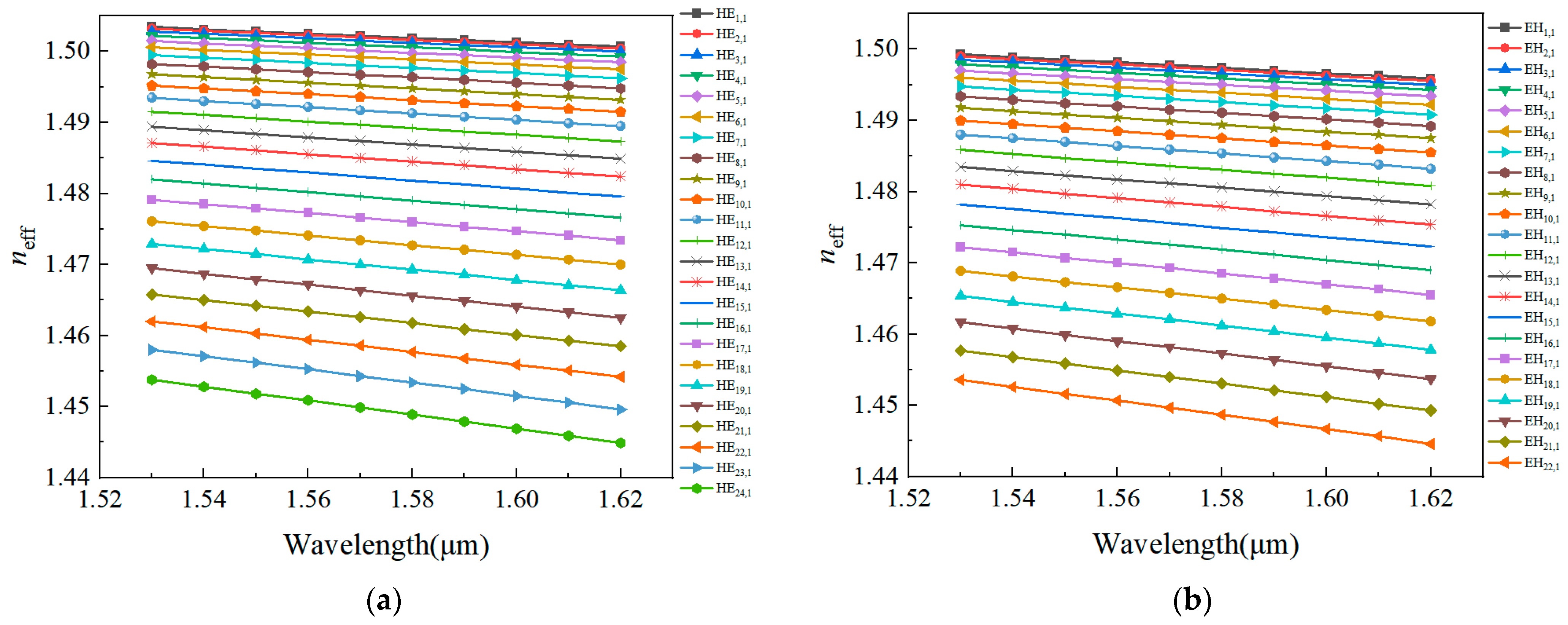

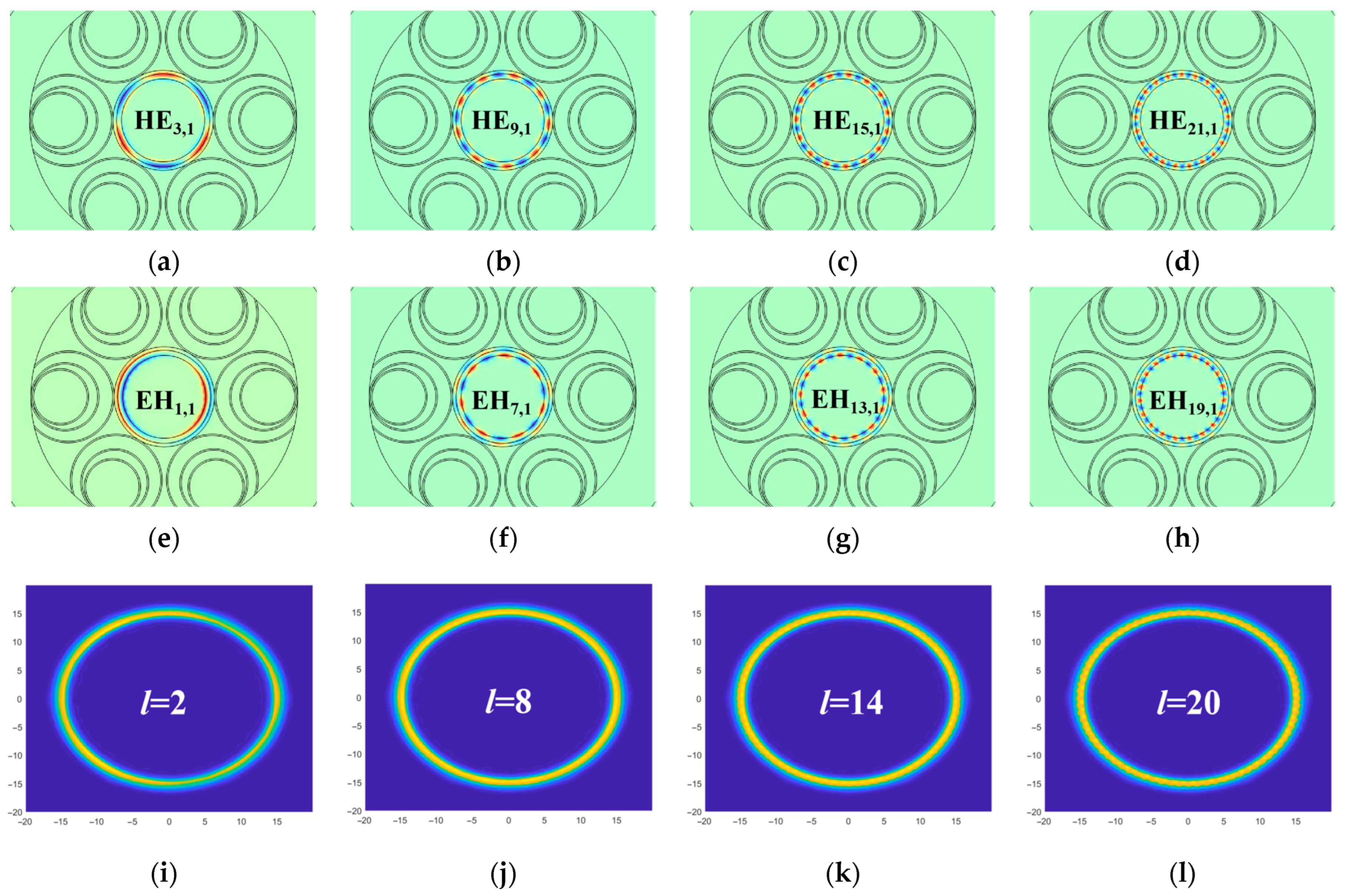

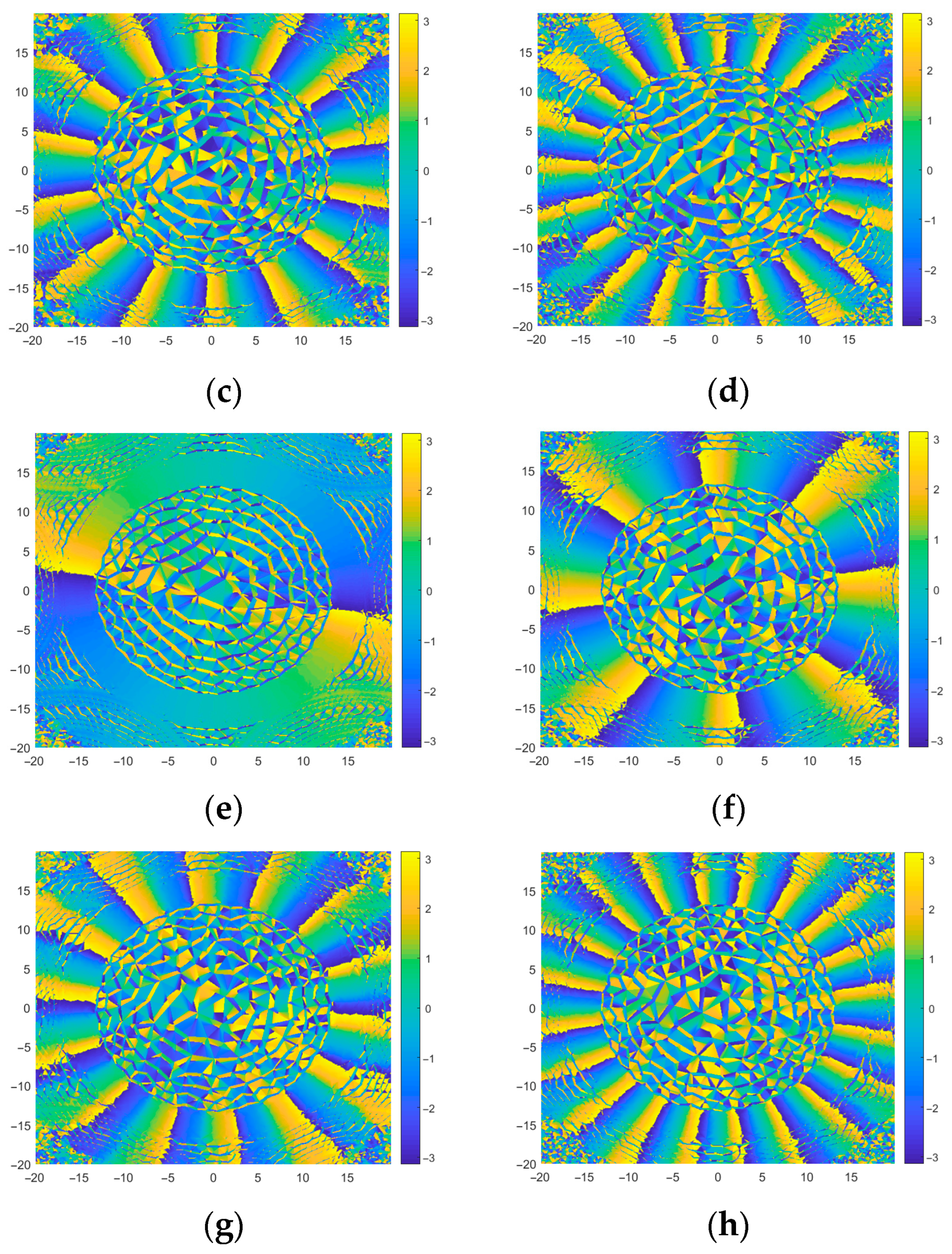





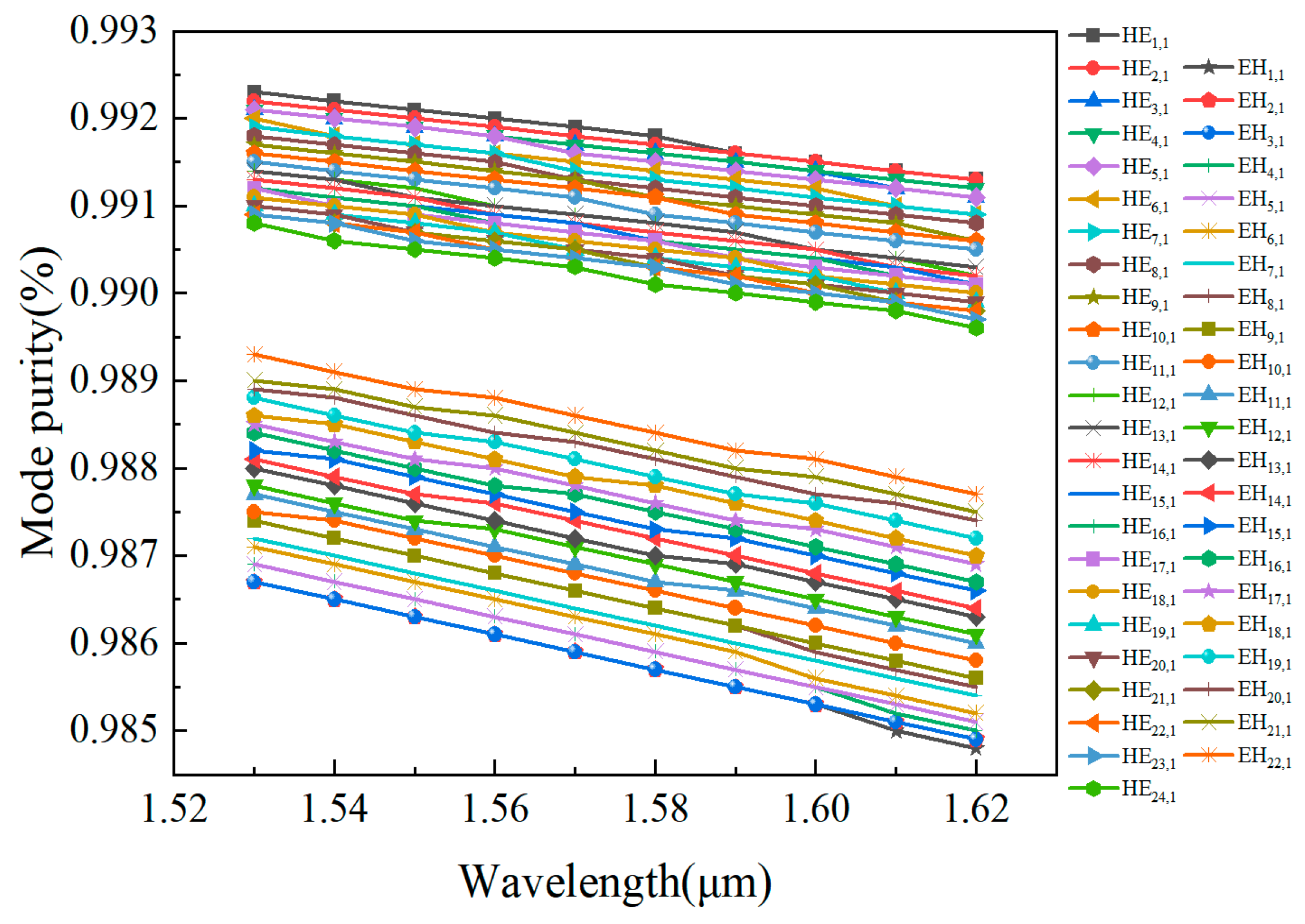
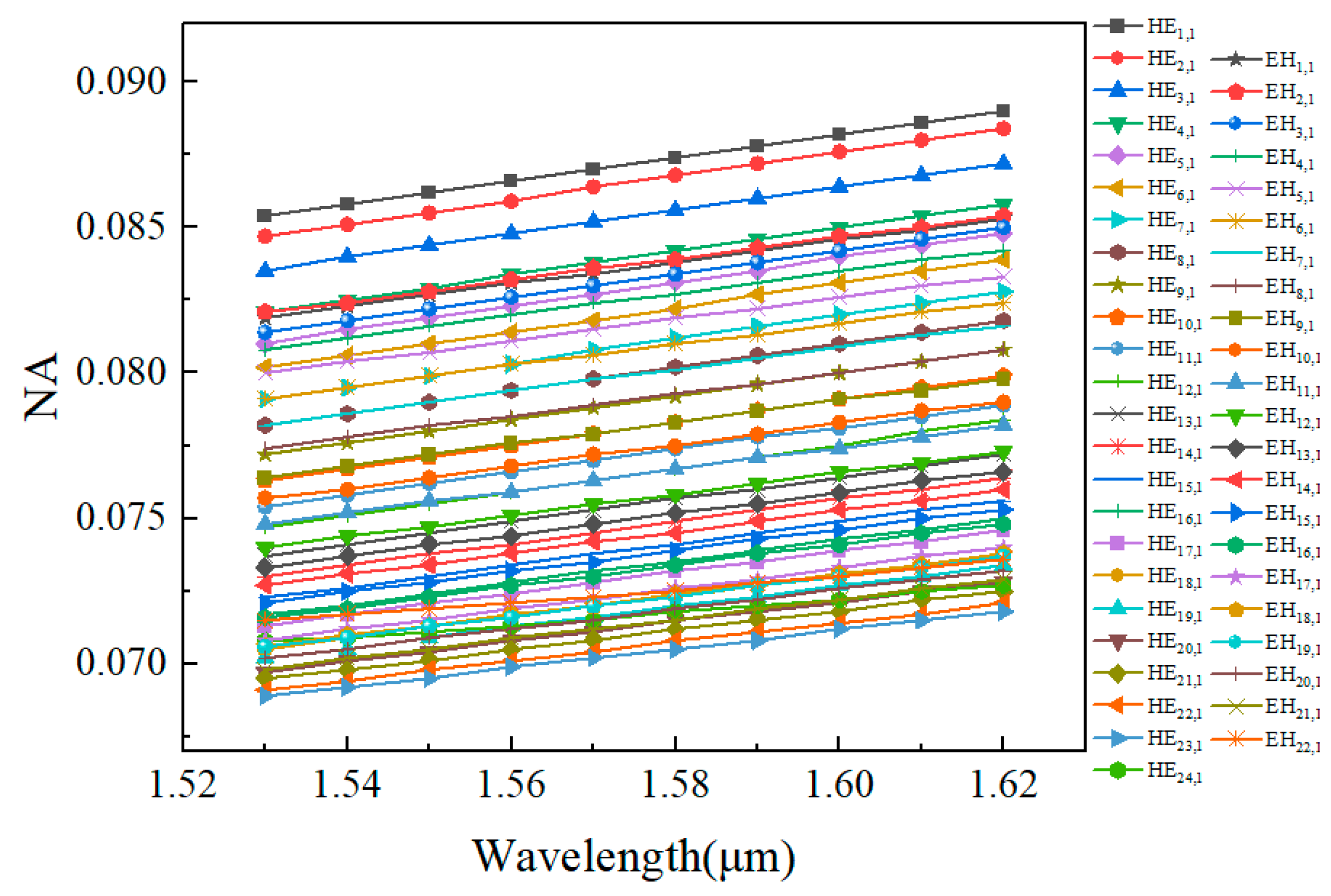
| References | Structure Type | Mode Number | Δneff | CLmin dB/m | γmax W−1·km−1 | ΔDmin ps/(nm·km) | Mode Purity |
|---|---|---|---|---|---|---|---|
| [10] | Circular-hole-cladding PCF | 26 | 0.009 | 5 × 10−10 | 2.08 | 39.84 | - |
| [11] | Rectangular-hole-cladding PCF | 46 | 0.008 | 1 × 10−10 | 2.58 | 0.21 | - |
| [12] | Hybrid-hole-cladding PCF | 101 | >1 × 10−4 | 1 × 10−8 | - | - | 78.7–90% |
| [13] | Dual-ring-core PCF | 30 + 50 | 0.003 | 1 × 10−8 | 2.65 | 2.7 | - |
| [14] | Dual-ring-core PCF | 62 + 22 | 0.0045 | 5 × 10−13 | 4.9 | 0.7 | 91.7–97% |
| [15] | Dual-ring-core PCF | 170 + 62 | 0.0035 | 1.56 × 10−12 | 1.5 | 5.9 | 92.5–96.5% |
| [16] | Doped-ring-core PCF | 110 | 0.001 | 1 × 10−7 | 2.8 | 32 | - |
| [17] | Doped-ring-core PCF | 56 | 0.04 | 1.74 × 10−11 | 4 | 36.907 | 89–93.7% |
| [18] | Doped-ring-core PCF | 114 | 0.0015 | 1 × 10−14 | 0.6 | - | 95–97.6% |
| [21] | Anti-resonant PCF | 64 | 0.07 | 2.7 × 10−6 | - | 8.838 | 97–99% |
| Proposed | Doped-ring-core anti-resonant PCF | 90 | 0.0041 | 5.16 × 10−12 | 1.05 | 0.5394 | 98.5–99.2% |
Disclaimer/Publisher’s Note: The statements, opinions and data contained in all publications are solely those of the individual author(s) and contributor(s) and not of MDPI and/or the editor(s). MDPI and/or the editor(s) disclaim responsibility for any injury to people or property resulting from any ideas, methods, instructions or products referred to in the content. |
© 2025 by the authors. Licensee MDPI, Basel, Switzerland. This article is an open access article distributed under the terms and conditions of the Creative Commons Attribution (CC BY) license (https://creativecommons.org/licenses/by/4.0/).
Share and Cite
Shi, H.; Jiang, L.; Wang, C.; Wu, J.; Ren, L.; Wang, P. A Ring-Core Anti-Resonant Photonic Crystal Fiber Supporting 90 Orbital Angular Momentum Modes. Photonics 2025, 12, 906. https://doi.org/10.3390/photonics12090906
Shi H, Jiang L, Wang C, Wu J, Ren L, Wang P. A Ring-Core Anti-Resonant Photonic Crystal Fiber Supporting 90 Orbital Angular Momentum Modes. Photonics. 2025; 12(9):906. https://doi.org/10.3390/photonics12090906
Chicago/Turabian StyleShi, Huimin, Linghong Jiang, Chao Wang, Junjun Wu, Limian Ren, and Pan Wang. 2025. "A Ring-Core Anti-Resonant Photonic Crystal Fiber Supporting 90 Orbital Angular Momentum Modes" Photonics 12, no. 9: 906. https://doi.org/10.3390/photonics12090906
APA StyleShi, H., Jiang, L., Wang, C., Wu, J., Ren, L., & Wang, P. (2025). A Ring-Core Anti-Resonant Photonic Crystal Fiber Supporting 90 Orbital Angular Momentum Modes. Photonics, 12(9), 906. https://doi.org/10.3390/photonics12090906




